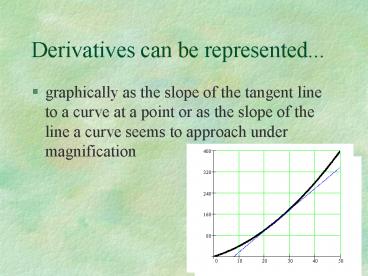Derivatives can be represented''' - PowerPoint PPT Presentation
1 / 14
Title:
Derivatives can be represented'''
Description:
Derivatives can be represented... necessary to students complete ... Mathcad. Mathematica. Derive. TI-89/92. TI-Interactive. Verify/Adjust Conjecture ... – PowerPoint PPT presentation
Number of Views:32
Avg rating:3.0/5.0
Title: Derivatives can be represented'''
1
Derivatives can be represented...
- graphically as the slope of the tangent line to a
curve at a point or as the slope of the line a
curve seems to approach under magnification
2
Derivatives can be represented...
- verbally as the instantaneous rate of change
3
Derivatives can be represented...
- physically as speed or velocity
4
Derivatives can be represented...
- symbolically as the limit of the difference
quotient
5
Why is the formal limit definition of derivative
important?
- necessary to students complete understanding of
derivative - for success in future mathematics study
- a mathematical idea or procedure or fact is
understood when it is part of an internal network - number and strength of the connections between
the parts of this network determine the degree of
understanding of a concept
6
Why is the formal limit definition of derivative
important?
Understanding Derivative
7
Why is the formal limit definition of derivative
important?
Understanding Derivative
8
How can technology/conjecturing be used to
strengthen these connections?
- Given a particular function, draw the derivative
function - Make a conjecture about the general derivative
function - Use Excel in a dynamic way to verify/adjust their
conjecture - Use Computer Algebra System for further support
9
Graph the derivative function
Given
Conjecture
10
Verify/Adjust Conjecture
- Using Excel
- Student created Excel spreadsheet will reinforce
the concept of the limit definition of derivative
11
Verify/Adjust Conjecture
- Using a Computer Algebra System
- Maple
- Mathcad
- Mathematica
- Derive
- TI-89/92
- TI-Interactive
12
Verify/Adjust Conjecture
13
Assessment
- Discuss each of the following questions with your
group and then provide a written response to
each. - 1. In the limit definition of derivative, what
role does the difference quotient play in the
computation of the derivative function? - 2. In the limit definition of derivative, what
role does the limit as approaches 0 play in the
computation of the derivative function?
14
Assessment
3. Generally speaking, the derivative of a a)
constant function is _____________________. b)
linear function is _______________________. c)
quadratic function is ____________________. d)
cubic function is _______________________. e)
quartic function is ______________________. f)
exponential function is ___________________. g)
sine function is _________________________. h)
cosine function is ______________________. i)
natural logarithm function is ______________. j)
absolute value function is ________________.































